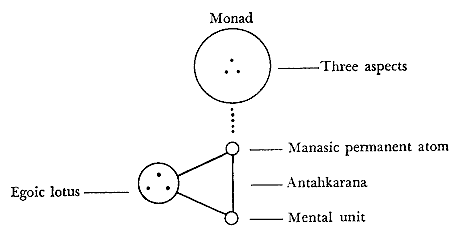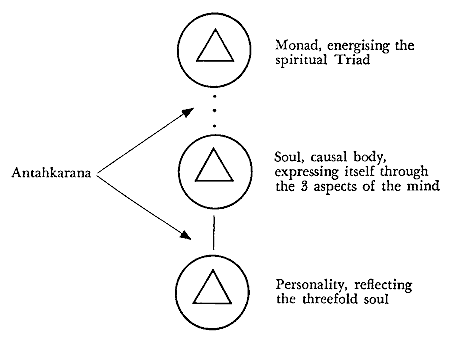| To Netnews Homepage Previous Next Index Table of Contents |
| The Rays and the Initiations - Part Two - Section One - The Aspirant and the Mysteries of Initiation |
These three major threads which are in reality six, if the
creative thread is differentiated into its component parts, form the antahkarana. They
embody past and present experience and are so recognized by the aspirant. It is only upon
the Path itself that the phrase "building the antahkarana" becomes accurate and
appropriate. It is in this connection that confusion is apt to arise in the mind of the
student. He forgets that it is a purely arbitrary distinction of the lower analyzing mind
to call this stream of energy the sutratma, and another stream of energy the consciousness
thread and a third stream of energy the creative thread. They are essentially, all three
of them together, the antahkarana in process of forming. It is equally arbitrary to call
the bridge which the disciple builds from the lower mental plane - via the egoic, central
vortex of force - the antahkarana. But for purposes of comprehending study and practical
experience, we will define the antahkarana as the extension of the threefold thread (hitherto
woven unconsciously, through life experimentation and the response of consciousness to
environment) through the process of projecting consciously the triple blended energies
of the personality as they are impulsed by the soul, across a gap in consciousness which
has hitherto existed. Two events can then occur:
Technically, and upon the Path of Discipleship, this bridge between the personality in its three aspects and the monad and its three aspects is called the antahkarana. This antahkarana is the product of the united effort of soul and personality, working together consciously to produce [455] this bridge. When it is completed, there is a perfect rapport between the monad and its physical plane expression, the initiate in the outer world. The third initiation marks the consummation of the process, and there is then a straight line of relationship between the monad and the lower personal self. The fourth initiation marks the complete realization of this relation by the initiate. It enables him to say: "I and my Father are one." It is for this reason that the crucifixion, or the Great Renunciation, takes place. Forget not that it is the soul that is crucified. It is Christ Who "dies." It is not the man; it is not Jesus. The causal body disappears. The man is monadically conscious. The soul-body no longer serves any useful purpose; it is no more needed. Nothing is left but the sutratma, qualified by consciousness - a consciousness which still preserves identity whilst merged in the whole. Another qualification is creativity; thus consciousness can be focused at will on the physical plane in an outer body or form. This body is will-created by the Master. But in this task of unfoldment, of evolution and of development, the mind of man has to understand, analyze, formulate and distinguish; therefore the temporary differentiations are of profound and useful importance. We might therefore conclude that the task of the disciple is:
In this simple symbol you have a picture of the disciple's task upon the Path. Another diagram may serve to clarify:
In these you have the "nine of initiation" or the transmuting of nine forces into divine energies: [457] |
| To Netnews Homepage Previous Next Index Table of Contents |
| Last updated Monday, July 6, 1998 © 1998 Netnews Association. All rights reserved. |

